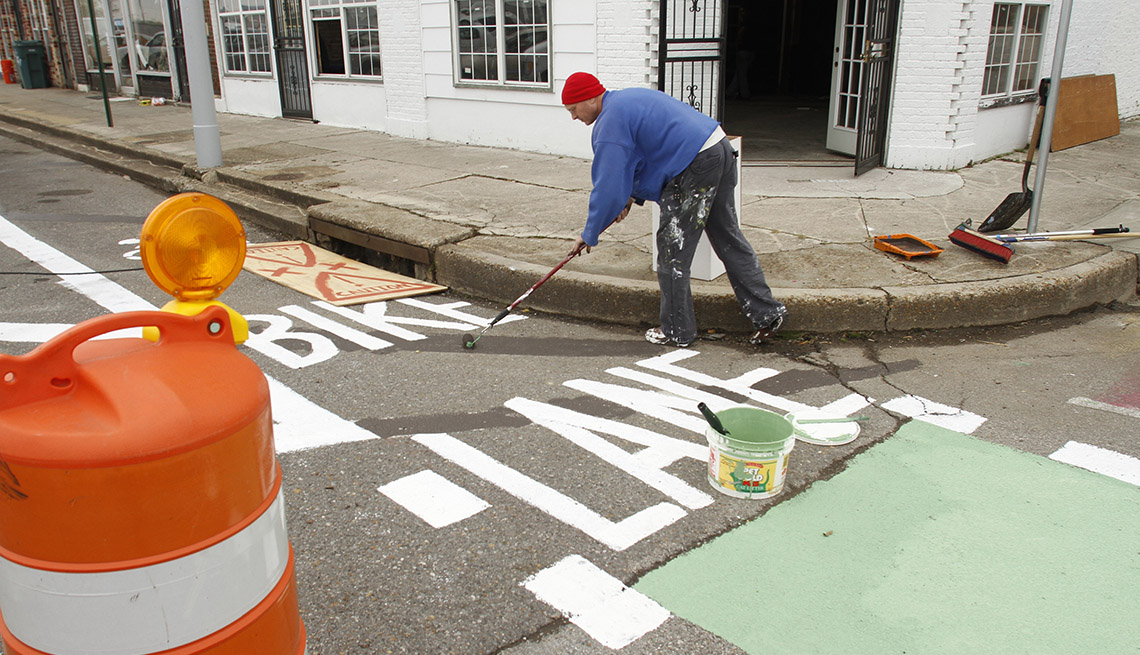
Project: Pop-Up Streetscape Revitalization
- Select a language for the TTS:
- UK English Female
- UK English Male
- US English Female
- US English Male
- Australian Female
- Australian Male
- Language selected: (auto detect) - EN
Play all audios:
Facebook Twitter Volunteers create a Broad Avenue bike lane. Photo courtesy Livable Memphis The Goal
To demonstrate the potential of Broad Avenue as a destination-worthy arts district
The BackstoryOnce a bustling commercial center, Broad Avenue had been turned into a divided highway that bisected — and thus disconnected — the Binghampton neighborhood's residential and commercial
areas. For decades, the district struggled with crime and blight. In 2006, Broad Avenue began to slowly emerge as an arts district. To truly thrive, however, the area needed the boost of
both emotional and financial investments.
The Project"A New Face for an Old Broad" was a temporary, three-block streetscape exhibition — populated by protected bike lanes, crosswalks, pedestrian refuge areas, pop-up shops, food vendors, and
activities for visitors of all ages — in order to spur interest in the area and show what a new arts district could look like.
The TimingThe event ran for two days in November 2010. (See a video about the streetscape exhibition.)
The LogisticsLivable Memphis, a nonprofit organization, teamed-up with the Broad Avenue Arts District. Using a borrowed and adapted concept from the Better Block Foundation, the groups gathered
volunteers and persuaded business owners to open temporary shops and restaurants.
Vacant storefronts were cleaned and paintedPeople who dreamed of opening a business were permitted tooccupy some of the vacant storefronts as demonstration businessesOpaque materials were removed from occupied storefronts to provide for friendlier and more inviting floor-to-ceiling
windowsCafes were extended onto the sidewalks
In addition, the team redesigned the street-level public spaces to illustrate how better infrastructure can breathe life into a commercial district. By focusing on bicyclists and pedestrians
instead of cars, the team:
Re-striped the 60-foot-wide Broad Avenue, adding crosswalks and protected bike lanesAngled and positioned on-street parking as a protective barrier for bikelanes and to increase parking spacesEssentially instituted a "road diet" that required vehicles to slowly ease (rather than speed) through two lanes while people walked and bicycled
nearbyTurned a vacant parking lot into a skate parkEnhanced street infrastructure by positioning street trees along the sidewalks and storefrontsCreated a "bump-out" to help slow traffic by
placing large planters filled with 10-foot cedars next to vehicle traffic lanesInstalled antique-style street lamps to provide better lighting ambience and security Local artist and event
volunteer Tom Clifton helped paint the event's pop-up bicycle lane. Photo courtesy Livable Memphis The Costs and Crew
The project received logistical and financial support from the Hyde Family Foundations, the Binghampton Development Corporation, the Memphis Regional Design Center, the City of Memphis and
the Community Development Council of Greater Memphis/Livable Memphis.
Outcomes and Next StepsThe event surpassed the organizers' expectations. Original goals targeted a turnout of 5,000 people; estimates are that 13,000 people attended the event.
"At first we were concerned that the bicycling would take away from business, but we quickly saw it was helping business twofold,” said Pat Brown, business manager of T. Clifton Art. "You
did have people biking, but it also helped narrow the street and slow people down. All of a sudden, people were noticing businesses they hadn't noticed before because they were speeding by
at 45 miles an hour or more."
Added David Wayne Brown, president of Splash Creative, an advertising agency: "We demonstrated that inner-city, old neighborhoods can be revitalized. Everything doesn't have to be
suburbanized, where we tear down the trees and build something new."
Since the demonstration project, Broad Avenue and the Binghampton neighborhood has seen more than $25 million in investments, the opening of more than two dozen new businesses and more then
30 property renovations. The temporary streetscape remained after the demonstration project. A more complete and permanent version will replace it when the Hampline path is constructed.
Through the Mayor's Innovation Delivery Team (now Innovate Memphis), a new program — MEMFix — was begun as a citywide cosponsored version of the "New Face for an Old Broad" Pop-Up
Project.
Other SolutionsAt least two, whimsically-designed MATA bus stops have opened in Binghampton and several interactive public art displays have been installed.
In addition, developer Eric Goode said the area's "guerrilla-style revitalization" has prompted him to turn a 12,000-square-foot former warehouse on Broad Avenue into a retail and restaurant
space.
Learn MoreRead a Livable Memphis Recap of the "New Face for an Old Broad" ProjectPage published Summer 2016
More from AARP.org/Livable
Use the dropdown to choose a livability topic.
Select a Subject Select a Subject AARP.org/Livable Home Page AARP Age-Friendly Network AARP Community Challenge AARP Livable Communities Newsletter AARP Livable Map Bicycling Community
Engagement Community Health and Wellness Community Resilience Community Diversity Economic Development High-Speed Internet Access Housing Inspiring Examples Livable Lessons Local Solutions
Placemaking Public Places and Outdoor Spaces Rural Livability Social Participation Surveys and Statistics Transportation Walkability Workshops and Conferences Zoning and Land Use